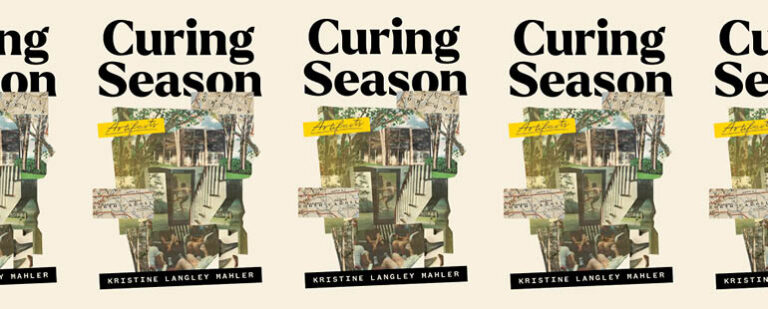Life and Death in Morgan Talty’s Night of the Living Rez
Morgan Talty’s “Safe Harbor” is the best short story I’ve read all year. In fact, Talty’s recently released collection, Night of the Living Rez, in which “Safe Harbor” and eleven other linked short stories appear, was the best collection I have read all year. The book follows David, a Penobscot boy living on a reservation in Maine. We find him in various years of his life, as he navigates death, crisis, and growing up. His voice is haunting: David is angry and sad, resigned and questioning, all at once. And with each decision he makes, more and more change comes. The world of Night of the Living Rez is deeply interconnected, leaving the reader to constantly wonder what each moment will set into motion.
Early reviews of the book seem to find this web of interconnection dark: like intergenerational trauma, the inevitability of something painful or sad is hard to witness, let alone experience. And it is dark. In the Wall Street Journal, Sam Sacks writes that “David comments that his reservation is ‘for the dead’ because it was built on a burial ground, but he also means something more bitter: There is no real life in this cursed place, only a shambling sort of living death, and the traditional spells that might have reversed the impulse to destruction have all been lost or forgotten.” David is right, of course, but the story of the destruction of one world has on its other side the generation of something new. It may not be a world fit for the living, but it is still a world—a new one, at that. Talty’s collection insists that the line between return—being doomed to repeat—and renewal—a second or third or fourth chance—is blurrier than we think.
Among the bitterness and darkness, there are also moments of hope, in the collection, that burn brightly. No story embodies this more clearly than “Safe Harbor,” in which David goes to visit his mother at a crisis center, some thirty minutes away from the reservation. The story gets its title from a small whiteboard in the crisis stabilization unit, where “in blue marker a quote is written: ‘A ship in harbor is safe, but that is not what ships are built for.’ Like human beings are ships, as if they were crafted things. Things that rock and bang or cruise smooth in an unpredictable ocean of salt and froth and depth. Out there is natural extermination.” David’s reflections here are telling. He finds this quote a little ridiculous and undercuts it to us—it seems shallow. The metaphor of person as ship fails him because he does not really see safe harbors or open waters in operation. It’s all just one thing, “natural extermination.”
The existential questioning in this story is central. What is the use of a ship—what is it built for? What is the use of a person? How unpredictable can a life really be? At its most basic, the question between David and his mother is one of inheritance, of what David gets from her. Is it only trauma? In the next story, “Smokes Last,” we find a younger David stealing cigarettes from his mother, and from his absent sister, who is at rehab. In “Safe Harbor,” in a telling reversal, David brings his mother cigarettes; he thinks to himself, “That’s why I’m here: to bring her cigarettes. That’s why I’m always here when she’s here. To bring her cigarettes. I never don’t bring her cigarettes.” His reflections are touching, his slanted double negative (“I never don’t”) both childlike in formation and adult in his sense of commitment and obligation.
Yet as they talk, David wants to be elsewhere. He wants to hear less about the Adam Sandler movie his mother has watched but misidentified, is not thrilled to fulfill his mother’s debts by bringing another woman at the center cigarettes. But when his mother suddenly has a seizure, the calculus changes: as David rubs her back, he thinks “about the cigarettes and the voice mails. The voice mails about the cigarettes she always wants. Right then I tell myself I will always bring her cigarettes; right then I tell myself I’ll watch that movie with Adam Sandler.” He is terrified for her. Yet her seizure is mirrored by a car accident David gets into on the way to the hospital, distracted from the road until he hits a playground at 65 mph. The results are as terrifying as the seizure: “when I look at my leg,” David thinks, “the skin is peeled back my pulsing meat in my face and I grab the flap of skin and flip it over my exposed bone and have you ever tried to walk in such a time of great rupture?”
This sentence stopped me in my tracks: “have you ever tried to walk in such a time of great rupture?” It could be a motto for David’s life, a life that seems marked by rupture. This accident, too, seems like an inheritance—a generational trauma, a reckoning that harks back to the second story in the collection, when David finds a jar of teeth at their house, a curse. His mother doesn’t recognize him after her seizure, asking “Who who you?” when she sees him. David doesn’t “repeat to her that I’m her son. I say my name instead, and her mouth and tongue move as if I’d taught her an unpronounceable word, like isthmus or Worcestershire. But she tries to say it again and again and again, failing each time.” David mirrors this too. After his accident, he is in the ER, and his stream of consciousness betrays a glimmer of this inheritance. He thinks, “As they did with Mom, the EMTs grab me and life me and settle me and poke me and quiet me and I recognize the man who would not let me leave and I say something something something to him.”
In quick succession, David repeats his mother’s accident—and instead of her being unable to recognize him, at the end of the story, it seems that he is unable to recognize her. “I’m there in a bustling room white curtain pulled closed and blue soft masks floating about me, and it goes how it should go the pain is hitting and a woman is yelling for her baby, and I feel bad that she lost that baby, hope she finds it, and before I’m put under to the sound of her screaming behind the curtain I grab the doc by the sleeve, say to the doc, ‘Does my mother know I’m here?’” The woman could be anyone, certainly, but the neat narrative circles of the story make it seem that the woman yelling for her baby is indeed David’s own mother. But even if not, even if the woman is someone else real or unreal, echoing the death of a child in the final story, David himself thinks of his mother.
Is it hopeful? Perhaps not. But it does seem that David’s mother enters a shadowy realm between death and life, unconscious as she seizes, and David follows her there. It is traumatic and it is inevitable, and it is also an expression of life. There’s something touching about the ways they strain to recognize each other in the midst of wreckage, to name each other—something generative. The safe harbor is not being with each other—that would be too reductive, too sentimental. Instead, they exist together in a world that has closed all their safe harbors, a world where being at sea is anything but unpredictable. We know it, in the previous story and the next one and the next and the next. Like his mother trying to say his name, they will keep failing each other, and they will keep trying to start again.


